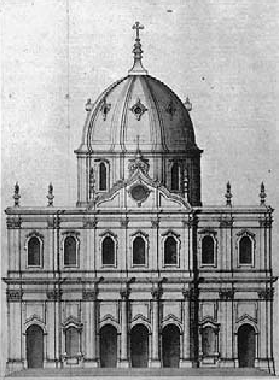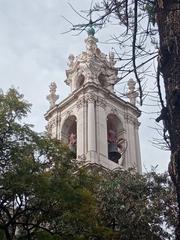
Estrela Basilica Visiting Hours, Tickets, and Guide to Lisbon Historical Sites
Date: 14/06/2025
Introduction
The Estrela Basilica (Basílica da Estrela) is one of Lisbon’s most iconic landmarks, representing a unique blend of late Baroque and Neoclassical architecture and deeply woven into Portugal’s religious, royal, and urban history. Commissioned by Queen Dona Maria I in 1779 as a votive offering for the safe delivery of her son, the basilica stands as the first church in the world dedicated to the Sacred Heart of Jesus—a devotion central to Catholic spirituality. With its impressive white limestone façade, twin bell towers, grand dome, and lavish interiors, the basilica is both a major spiritual center and a top attraction for visitors wanting to explore Lisbon’s historical and cultural treasures.
This guide covers everything you need: historical background, visiting hours, ticket information, accessibility, travel tips, and nearby attractions. For more details and planning resources, consult Portugal Visitor, Lisboa Secreta, and We Heart Lisbon.
Table of Contents
- Introduction
- Historical Background
- Exterior Design and Façade
- Dome and Rooftop Viewpoint
- Interior Layout and Materials
- Artistic Highlights
- Tomb of Queen Maria I
- Organs and Musical Heritage
- Structural Innovations
- Symbolism and Decorative Motifs
- Visitor Information
- Cultural & Religious Significance
- Practical Visitor Information
- Photographic Spots & Travel Tips
- FAQ
- Conclusion & Call to Action
- References
Historical Background
Origins and Royal Patronage
The Estrela Basilica was commissioned by Queen Dona Maria I as an expression of gratitude for the birth of her son, José, Prince of Brazil. Construction began in 1779, and the basilica was completed in 1790. The queen’s personal investment is evident—her tomb rests within the basilica. Tragically, her son died in 1788 before the basilica’s completion, adding a layer of poignant history to the building (Portugal Visitor).
Architectural Vision and Influences
Designed initially by Mateus Vicente de Oliveira and completed by Reinaldo Manuel dos Santos, the basilica’s architecture marks the transition from Baroque to Neoclassical styles. Its monumental façade, inspired by the Mafra National Palace and St. Peter’s Basilica in Rome, features twin bell towers and a grand dome that dominates the Lisbon skyline (Cod and Ham).
Artistic Features and Interior Decoration
The interiors showcase a dazzling array of colored marbles in geometric patterns, gilded stucco, and chandeliers. The basilica is especially famed for its large nativity scene (presépio) by Joaquim Machado de Castro, with more than 500 cork and terracotta figures, considered a masterpiece of Portuguese religious art (Lisboa Secreta).
Exterior Design and Façade
The basilica’s white limestone façade is divided into two levels and seven panels, adorned with Doric columns, round arches, and allegorical statues. The twin bell towers and majestic dome evoke both Italian and Portuguese influences. Visitors approach via a broad staircase, lending a sense of grandeur and inviting closer inspection of the detailed sculptures (Lisboa Secreta).
Dome and Rooftop Viewpoint
The basilica’s central dome, rising approximately 60 meters, is constructed from grey and pink marble and topped with exquisite carvings. Visitors can climb 112 steps to a rooftop terrace for panoramic views of Lisbon and the Tagus River. The bell tower houses a 54-bell carillon, including one of Portugal’s largest bells (Along a Travel; The Geographical Cure).
Interior Layout and Materials
Inside, the nave is a marvel of marble in shades of grey, pink, and yellow, arranged in geometric Rococo patterns (Mad About Lisbon). Stained-glass windows and the dome’s oculus flood the space with natural light, illuminating the richly decorated side chapels and altars (Wikipedia).
Artistic Highlights
Paintings and Frescoes
The basilica houses paintings by Italian Rococo artist Pompeo Batoni and Portuguese artist Pedro Alexandrino, which adorn altars and chapels, enhancing the harmonious design (Lisboa Secreta; The Geographical Cure).
Sculptural Masterpieces
Joaquim Machado de Castro’s nativity scene (presépio) stands out, with over 500 meticulously crafted figures. This celebrated display is a year-round attraction and a highlight during Christmas (Catholic Shrine Basilica).
Tomb of Queen Maria I
The right transept houses Queen Maria I’s Neo-Classical tomb, designed by Faustino José Rodrigues and Giovanni Chiari, made from white, black, and pink marble. Sculpted lions and inscriptions honor the queen and reinforce the basilica’s royal connections (Along a Travel; Lisbon Portugal Tourism).
Organs and Musical Heritage
Two 18th-century pipe organs remain operational, regularly featured in concerts and liturgical events, adding to the basilica’s sensory and cultural experience (Cod and Ham).
Structural Innovations
The basilica incorporates the Pombaline cage technique—an earthquake-resistant architectural method using timber and metal rods within masonry, developed after Lisbon’s 1755 earthquake (Along a Travel). An underground cistern was historically used for water storage.
Symbolism and Decorative Motifs
The interior is rich with celestial and astrological imagery, including marble stars and iconography celebrating the Sacred Heart of Jesus—the basilica’s primary dedication (Lisboa Secreta).
Visitor Information
Visiting Hours & Tickets
- Basilica: Open daily, 8:45 AM–8:00 PM. Hours may vary on religious holidays or special events (Patriarchate of Lisbon).
- Rooftop/Dome: Accessible 10:00 AM–1:00 PM and 3:00 PM–6:40 PM.
- Admission: Entry to the basilica is free. Rooftop/dome access: €4 (adults), €2 (students/seniors), free for children under 12. Nativity scene: €2 (The Geographical Cure).
How to Get There
- Tram: Lines 25 & 28 stop at “Estrela” (Carris).
- Metro: Rato station (Yellow Line), 10–15 min walk (Metro Lisboa).
- Bus: 709, 713, 720, and 738 serve the area.
- Parking: Limited; public transport recommended.
Accessibility
- Main entrance has a ramp; nave is wheelchair-friendly.
- Rooftop is not accessible due to 112-step spiral staircase (Accessible Portugal).
- Accessible restrooms and tactile maps/braille panels are available.
Best Times to Visit
- Weekday mornings for fewer crowds.
- Sunset for panoramic rooftop views.
- Special events like the Feast of the Sacred Heart of Jesus in June attract more visitors.
Guided Tours & Audio Guides
- Guided Tours: Available in Portuguese and English, bookable via Lisbon Official Tours; tours last 45–60 minutes, from €8/person.
- Audio Guides: €2, available on-site in multiple languages.
Dress Code & Visitor Etiquette
- Modest dress: cover shoulders/knees, remove hats.
- Photography allowed without flash/tripods, except during services.
- Remain silent and respectful during worship.
Facilities & Amenities
- Restrooms near entrance.
- Gift shop with religious souvenirs.
- No café inside, but several nearby.
- No free Wi-Fi inside.
Safety & Security
- Security staff and CCTV on-site.
- Secure your belongings; pickpocketing is rare but possible (Safe Communities Portugal).
Language & Communication
- Portuguese is official, English widely spoken.
- Signage in Portuguese, English, French, and Spanish.
- Lisbon Tourist Office for assistance (Visit Lisboa).
Photographic Spots & Travel Tips
- The façade from Praça da Estrela for exterior shots.
- Dome and rooftop terrace for city and river panoramas—best at sunset.
- Visit early for serene interiors and optimal lighting.
- Combine your visit with a stroll in Jardim da Estrela or explore nearby São Bento Palace.
FAQ
Q: Is there an admission fee?
A: Entry is free; rooftop and nativity scene require tickets.
Q: Are guided tours available?
A: Yes, in Portuguese and English.
Q: Is it wheelchair accessible?
A: Main nave is accessible, rooftop is not.
Q: Can I take photos inside?
A: Yes, without flash/tripods; not during Mass.
Q: What are the best times to visit?
A: Weekday mornings and sunset for fewer crowds and best views.
Conclusion & Call to Action
The Estrela Basilica is a quintessential Lisbon experience, blending royal history, religious devotion, and architectural artistry. Its grand dome, exquisite interiors, and panoramic city views make it a must-visit for any traveler. Plan your visit with this guide, and don’t forget to explore nearby Jardim da Estrela and other historic sites for a full cultural immersion.
For more travel guides and insider tips, download the Audiala app, visit our site, and follow us on social media for the latest on Lisbon’s historical treasures.



























































